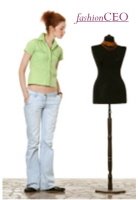I was going through some old receipts the other day and it reminded me of all the money I spent on unnecessary things when I was starting my handbag business. I immediately broke out in a sweat. I know you have to make mistakes when starting a business, but when its your hard-earned money that has gone down the drain, its sometimes hard to swallow. I'm not sure why hindsight is 20/20, but boy, it really is. Looking back, I think about what poor decisions I made. But at the time, they seemed like necessary actions to launch my handbag business into the stratosphere.
I decided it might be therapeutic to make a list of the top 10 things to waste your money on when starting an indie fashion business. Perhaps it will save you a few bucks if you are just starting out. If you don't care about money, or have it coming out of your ears, then by all means, starting warming up that checkbook on the following items.
TOP 10 THINGS TO WASTE YOUR MONEY ON WHEN STARTING AN INDIE FASHION BUSINESS10. A dedicated phone and fax line in your house for your business a good long year before you officially launch it. $55 month x 12 months = A big waste of money for a phone/fax that never rang (use email and your cell phone until you need the real thing).
9. Expensive leather/fabric to use as your "scrap" material while you practice sewing, especially if you can't sew and hate it to begin with. Leather at $12/sq ft x alot of feet = really dumb
8. A trademark for your surname (in my case, Denney). Not necessary, don't do it. If you have made up a name for your line that isn't your surname, you might look into getting a trademark, but test the waters first. Make sure you are going to use the name you want to protect before calling the attorney. In my case...$1100 x 1 trademark = a trademark for "Denney Bags". Yea.
7. A web designer that isn't reliable. I ended up doing a website for myself which I liked better. Not everyone wants to spend time doing their own website, and that's probably good. Just make sure you hire someone you trust and who will do a good job for you. $2500 for one web designer who couldn't spell and took a month to fix a typo = one unhappy Susan.
6. A logo you'll never use. And be leary of friends you don't know too well. A "friend" offered to make a logo for me in exchange for a bag for his mom. He then sent me a bill for $400. I gave him $200. $200 for a logo I didn't want = sucker.
5. Press kit before you are ready. I hired a PR company to make a press kit and distribute it for me. I thought having a real PR firm was going to take my business up a notch. I wasn't even ready for any real press because I didn't have my manufacturing in place. $2600 x press kit that my 14 year old niece could have done better = more interest on my credit card.
4. Industrial sewing machine. I will say I got a good deal on it by buying a refurbished one, but I don't like to sew and I'm not very good at it anyway. If you don't plan to sew your designs, don't invest in machinery. $800.00 = my mom suggesting I start making my own curtains. Need I say more?
3. A large quantity of anything before you finalize your logo. I bought 1000 "Denney" labels to sew on my bags. A couple months later I changed my logo. Now I like to see if the labels will stick to my dogs. I think I still have 980 of them. $300 x 1000 labels with an old logo = well, a bunch of labels with my old logo.
2. A merchant account before you need it. I spent $40 a month for about 18 months so I could except credit cards. I never used it because I wasn't selling my bags yet. But I wanted to be "prepared". Use Paypal if you sell through your website! Or at the very least, wait until you are ready to sell before getting a merchant account. $40/month x 18 months = a richer merchant account company thanks to me.
1. A whole lot of supplies you'll never use. I bought a truck full of sewing supplies from a woman who used to work at Samsonite. She was cleaning out her basement and selling it all for one price. I thought because it was sewing supplies, such as rolls of plastic zippers, vinyl and other miscellaneous stuff, I'd be able to use it somehow. Now instead of it taking up room in her basement, its taking up room in mine. $400 x tons of supplies I'll never use = tons of supplies I'll never use.
In all honesty, I got excited at the idea of being a fashion designer, and I thought somehow these things would make it more real. If you need these things to help you feel like a real designer, then stop what you are doing, put the checkbook down and get a reality check. Save yourself alot of money by being patient and focusing on the core things you need to be successful. Don't mistake this to mean you can skimp on quality by using cheap stuff. Definitely not!! Quality is key. If you are going to invest in anything, invest in the quality of your product. The rest will fall into place.
Have a fashionable day!
S






